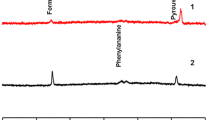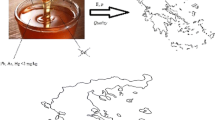Abstract
Pine honey is highly appreciated by consumers because of its non-crystallization, appearance, color, taste, and unique aroma. The objective of this study was to investigate the volatile compounds of pine honeys from 23 stations from 7 regions in Turkey’s Aegean and Mediterranean regions. Solid-phase microextraction, followed by gas chromatography (GC) and gas chromatography–mass spectrometry (GC–MS) systems were used to determine volatile compounds qualitatively and quantitatively. A total of 32 volatile compounds were identified and octanol, nonanol, 4,4,7-α-trimethyl 2,4,5,6,7-α-hexahydro-1-benzofuran-2-yl-methanol, benzaldehyde, octanal, phenylacetaldehyde, nonanal, decanal, 2-nonanone, 4-oxoisophorone, methyl salicylate, α-pinene, β-pinene, limonene, cis-linalool oxide, borneol, 1,8-cineole, and β-damascenone were found to be common volatile compounds. The classification based on the geographical origin of pine honey samples was determined using principal component analyses (PCA) and hierarchical clustering analyses (HCA). These results revealed that nonanal, nonanol, octanol, decanal, phenylacetaldehyde, benzaldehyde, octanal, α-pinene, 4-oxoisophorone, methyl salicylate, isopropyl myristate, limonene, and β-damascenone could be used as marker compounds in Turkish pine honeys.
Graphic abstract





Similar content being viewed by others
References
Anonymous (2020) 2020/7 numbered turkish food codex communiqué on honey. Republic of Turkey, Ministry of Agriculture and Forestry, Ankara
Manyi-Loh CE, Ndip RN, Clarke AM (2011) Volatile compounds in honey: a review on their involvement in aroma, botanical origin determination and potential biomedical activities. Int J Mol Sci 12(12):9514–9532
Darvishzadeh A, Hosseininaveh V, Nehzati G, Nozari J (2015) Effect of proline as a nutrient on hypopharyngeal glands during development of Apis mellifera (Hymenoptera: Apidae). Arthropods 4(4):137–143
Samarghandian S, Farkhondeh T, Samini F (2017) Honey and health: a review of recent clinical research. Pharmacogn Res 9(2):121–127
Hatjina F, Bouga M (2009) Portrait of marchalina hellenica gennadius (hemiptera: margarodidae), the main producing insect of pine honeydew-biology, genetic variability and honey production. Uludag Bee J 9(4):162–167
Tananaki Ch, Thrasyvoulou A, Giraudel JL, Montury M (2007) Determination of volatile characteristics of Greek and Turkish pine honey samples and their classification by using kohonen self organising maps. Food Chem 101:1687–1693
Özkök A, Yüksel D, Sorkun K (2018) Chemometric evaluation of the geographical origin of turkish pine honey. Food Health 4(4):274–282
Eraslan G, Kanbur M, Silici S, Karabacak M (2010) Beneficial effect of pine honey on trichlorfon induced some biochemical alterations in mice. Ecotoxicol Environ Saf 73:1084–1091
Dimou M, Katsaros J, Klonari KT, Thrasyvoulou A (2006) Discriminating pine and fir honeydew honeys by microscopic characteristics. J Apic Res 45(2):16–21
Rodríguez-Flores MS, Escuredo O, Míguez M, Seijo MC (2019) Differentiation of oak honeydew and chestnut honeys from the same geographical origin using chemometric methods. Food Chem 297:124979
Seijo MC, Escuredo O, Rodríguez-Flores MS (2019) Physicochemical properties and pollen profile of oak honeydew and evergreen oak honeydew honeys from Spain: a comparative study. Foods 8:126
Soria AC, Gonzalez M, Lorenzo C, Martinez-Castro I, Sanz J (2004) Characterization of artisanal honeys from Madrid (Central Spain) on the basis of their melissopalynological, physicochemical and volatile composition data. Food Chem 85(1):121–130
Louveaux J, Maurizio A, Vorwohl G (1978) Methods of melissopalynology. Bee World 51:125–131
FAO (2019) Honey production statistics. http://www.fao.org/faostat/en/#data/QL. Accessed 24 June 2021
Çinar SB, Ekşi A, Coşkun İ (2014) Carbon isotope ratio (13C/12C) of pine honey and detection of HFCS adulteration. Food Chem 157:10–13
Korkmaz SD, Kuplulu O, Cil GI, Akyuz E (2017) Detection of sulfonamide and tetracycline antibiotic residues in Turkish pine honey. Int J Food Prop 20:50–55
Turkish Ministry of Agriculture and Forestry (2020) Beekeeping, agricultural products market report. https://arastirma.tarimorman.gov.tr/tepge/Menu/27/Tarim-Urunleri-Piyasalari. Accessed July 2020
Karabagias IK, Badeka A, Kontakos S, Karabournioti S, Kontominas MG (2014) Characterisation and classification of Greek pine honeys according to their geographical origin based on volatiles, physicochemical parameters and chemometrics. Food Chem 146:548–557
Can Z, Yildiz O, Sahin H, Akyuz Turumtay E, Silici S, Kolayli S (2015) An investigation of Turkish honeys: their physico-chemical properties, antioxidant capacities and phenolic profiles. Food Chem 180:133–141
Özkök A, Çıngı H (2010) Two different methods used in distinguishing pine honey from floral honey. Mellifera 10(20):14–23
Machado AM, Miguel MG, Vilas-Boas M, Figueiredo AC (2020) Honey volatiles as a fingerprint for botanical origin-a review on their occurrence on monofloral honeys. Molecules 25:374
Manyi-Loh CE, Ndip RN, Clark AM (2011) Volatile compounds in honey: a review on their involvement in aroma, botanical origin determination and potential biomedical activities. Int J Mol Sci 12:9514–9532
Ozcan-Sinir G, Copura OU, Barringer SA (2020) Botanical and geographical origin of Turkish honeys by selected-ion flow-tube mass spectrometry and chemometrics. J Sci Food Agric 100:2198–2207
Selli S, Guclu G, Sevindik O, Yetisen M, Kelebek H (2020) Characterization of aroma-active compounds and stable carbon isotope ratios in Turkish pine honeys from two different regions. J Food Process Preserv. https://doi.org/10.1111/jfpp.14544
Silici S (2011) Determination of volatile compounds of pine honeys. Turk J Biol 35:641–645
Bayraktar D, Onoğur TA (2011) Investigation of the aroma impact volatiles in Turkish pine honey samples produced in Marmaris, Datca and Fethiye regions by SPME/GC/MS technique. Int J Food Sci Technol 46:1060–1065
Karabagias IK, Halatsi EZ, Kontakos S, Karabournioti S, Kontominas MG (2017) Volatile fraction of commercial thyme honeys produced in Mediterranean regions and key volatile compounds for geographical discrimination: a chemometric approach. Int J Food Proper 20(11):2699–2710
Aliferis KA, Tarantilis PA, Harizanis PC, Alissandrakis E (2010) Botanical discrimination and classification of honey samples applying gas chromatography/mass spectrometry fingerprinting of headspace volatile compounds. Food Chem 121:856–862
Perez RA, Sanchez-Brunete C, Calvo RM, Tadeo JL (2002) Analysis of volatiles from spanish honeys by solid-phase microextraction and gas chromatography-mass spectrometry. J Agric Food Chem 50(9):2633–2637
Adams RP (2007) Identification of essential oil components by gas chromatography/mass spectrometry, 4th edn. USA, Allured Publishing Corporation, Illinois
Jia X, Zhou Q, Wang J, Liu C, Huang F, Huang Y (2019) Identification of key aroma-active compounds in sesame oil from microwaved seeds using E-nose and HS-SPME-GC×GC-TOF/MS. J Food Biochem. https://doi.org/10.1111/jfbc.12786
Castro-Vázquez L, Díaz-Maroto MC, González-Viñas MA, Pérez-Coello MS (2009) Differentiation of monofloral citrus, rosemary, eucalyptus, lavender, thyme and heather honeys based on volatile composition and sensory descriptive analysis. Food Chem 112:1022–1030
Castro-Vázquez L, Leon-Ruiz V, Alañon ME, Pérez-Coello MS, González-Porto AV (2014) Floral origin markers for authenticating Lavandin honey (Lavandula angustifolia x latifolia). Discrimination from Lavender honey (Lavandula latifolia). Food Control 37:362–370
Costa ACV, Garruti DS, Madruga MS (2019) The power of odour volatiles from unifloral melipona honey evaluated by gas chromatography–olfactometry osme techniques. J Sci Food Agric 99(9):4493–4497
Escriche I, Visquert M, Juan-Borrás M, Fito P (2009) Influence of simulated industrial thermal treatments on the volatile fractions of different varieties of honey. Food Chem 112:329–338
Kaškoniene V, Venskutonis PR, Ceksteryte V (2008) Composition of volatile compounds of honey of various floral origin and beebread collected in Lithuani. Food Chem 111:988–997
Patrignani M, Fagúndez GA, Tananaki C, Thrasyvoulou A, Lupano CE (2018) Volatile compounds of argentinean honeys: correlation with floral and geographical origin. Food Chem 246:32–40
Seisonen S, Kivima E, Vene K (2015) Characterisation of the aroma profiles of different honeys and corresponding flowers using solid-phase microextraction and gas chromatography–mass spectrometry/olfactometry. Food Chem 169:34–40
Soria AC, Sanz J, Martínez-Castro I (2009) SPME followed by GC–MS: a powerful technique for qualitative analysis of honey volatiles. Eur Food Res Technol 228:579–590
Tahir HE, Xiaobo Z, Xiaowei H, Jiyong S, Mariod AA (2016) Discrimination of honeys using colorimetric sensor arrays, sensory analysis and gas chromatography techniques. Food Chem 206:37–43
Uckun O, Selli S (2017) Characterization of key aroma compounds in a representative aromatic extract from citrus and astragalus honeys based on aroma extract dilution analyses. J Food Meas Charact 11:512–522
Acknowledgements
The authors would like to thank Mr. Ziya Şahin, Turkish Association of Beekeepers (TAB), Ministry of Agriculture and Forestry, and General Directorate of Agricultural Research and Policies (TAGEM) for providing the pine honey samples.
Author information
Authors and Affiliations
Corresponding authors
Ethics declarations
Conflict of interest
The authors declare that they have no known competing financial interests or personal relationships that could have appeared to influence the work reported in this paper.
Additional information
Publisher's Note
Springer Nature remains neutral with regard to jurisdictional claims in published maps and institutional affiliations.
Rights and permissions
About this article
Cite this article
Duru, M.E., Taş, M., Çayan, F. et al. Characterization of volatile compounds of Turkish pine honeys from different regions and classification with chemometric studies. Eur Food Res Technol 247, 2533–2544 (2021). https://doi.org/10.1007/s00217-021-03817-8
Received:
Revised:
Accepted:
Published:
Issue Date:
DOI: https://doi.org/10.1007/s00217-021-03817-8




